CTR Press
By
Maryam Tajfar
and
Mel Bolero
Henry Gide
July 2017:
July 26-27, 2017:
Forward JS 2017
San Francisco
The speakers of Forward JS discussed the latest in Activity GIS Data Visualization tools, the way JS developers shape the future of internet security and privacy, visual programming, immersive analytics, design systems, GraphQL and D3, Typescript and deep learning. Efrem Rensi talked about Heatflask: GIS data visualization tool. He introduced Heatflask as a web application that producing cyclic animated data visualization and then encoding them as GIFs. He showed many demos and explained the process from visualization to analysis. He said: “I love to have google data.” And he added: “Google timeline: they know your position 24/7.” He showed demo of all the users movements; the records of the activities of all the people registered with his app for the fast five days.

Amelia Abreu talked about the way JS developers shape the future of internet security. She explained the full stack JS tools and IoT. She emphasized on the necessity of building the trustworthy security for internet and improving the end user experience. She mentioned: “improving the user experience of security tools for developers leads to improvement in usability for end users.” She emphasized on building much better tools for the developers and she said:” Breaking the mold is fun.” The next speaker discussed visualizing the data and mentioned that even bar charts and line charts had been effective ways for presenting data. He pointed out that complex data visualization is very dependent on the codes and is very time consuming. He added that JavaScript is not scalable and emphasized on the system to control building blocks and core architecture in the process of creating data visualization. He emphasized on the creating a new approach to build data visualization. He added: “we can do complex analytics by just using charts.”
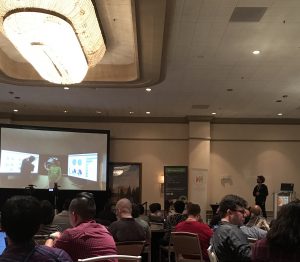
Marigolis discussed Immersive Analytics. He explained that immersive analytics: blending analytical reasoning with immersive virtual spaces for achieving collaborative decision making. He discussed Scheduling and rendering services and challenges on complex data. He emphasized on being in an immersive environment and finding a new insight with focus on complex data. He discussed Augmented reality, virtual reality and tablets as different factors. Federman talked about design systems. She started her talk with a joke: “How a man cut his hair on the moon? He clips it!” She mentioned that engineers who understand the design ask more question about UX. UX design is the process of designing useful and easy to use products. It enables the experience of interacting with the product by the users. She also discussed the risks of making design system: staying up to date is very hard. She talked about different types of design systems, the resources for the building design system tools for designers and building a complex system. Bugsnag with the moto: “beautifully simple error monitoring” exhibited the service for building the software that monitors application errors and improves customer experience and code quality. CTR Press
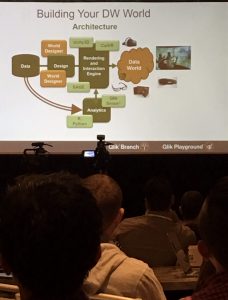
July 25-26, 2017:
Wearable Technologies 2017 USA
San Francisco
Wearable Technologies conference was organized by The WT Group that has offices around the world and its headquarter is in Munich. Since 2006 the market development platform for technologies worn close to the body has established an ecosystem of about 30,000 companies. The speakers and the attendees discussed the latest innovations in the wearable market industry. Rowley talked about smart glasses. He mentioned that some companies use the Radio Frequency ID chips installed in the bodies of their employees and constantly tracking them. He pointed out that doctors are still skeptical about the data collected by the wearables about their patients. He said:” we are just at the beginning.” Brandt, CMO Safilo mentioned: “The company is based in Italy and is over 100 years old.” He criticized Google glass: “Google glass is a terrible product; it is heavy and is not good for the eyes.” He added that putting all functions of smart phones on your face doesn’t work. He introduced their product, a light sunglass with EEG that tracking brain waves. He emphasized on making the products less visible.
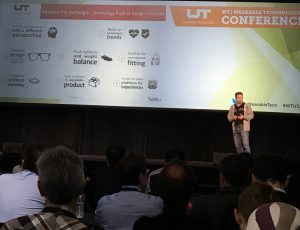
Alain Porret and his colleagues explained LoRa and how it is used in many applications. He mentioned that devices with Geo location capabilities without using GPS will be the future innovation. Next speaker discussed Machine learning, Face recognition, emotion recognition and sound recognition devices. He mentioned that some devices cost less than $50 today. Liz McCurdy from Google talked about fitness App with Google Play. She discussed gaming economy and praised Creating the sense of motivation by Pokémon Game that caused people to be more active. Some members of audience disagreed. She talked about Leveraging third party data to provide recommendations for the gaming. In the response to the question about Google tracking data and privacy issues she replied: “60% of people are happy to share their data and get value.” She didn’t mentioned the source of the research.
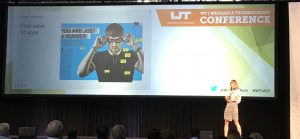
Katz talked about increasing retention and lifetime value with an open approach. He discussed how to create consumer value. He compared the Low engagement users and the high engagement users that use wearable everyday. He mentioned: “the reason for their low engagement is that functionality of the devices are limited and that’s why is the customer loosing interest.” He added: ” one solution is gamification.”
Miehlich from Varta explained the 130 years old company. He discussed Sensing biometric data and pointed out: “Most concentration of data in body is around the ears.” He explained a big demand to make the product: the special battery with Energy density in the market.
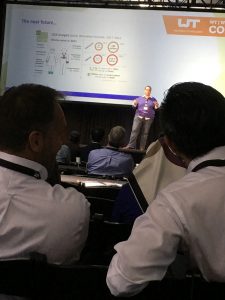
Electronic-privacy advocates argue that trackable data is hackable data, and that someone, somewhere, could find a way to invade the privacy of people using wearables. In the exhibition area a variety of companies exhibiting their latest products. ejoy from Italy provides emotional jewelry that is a collection of technological bracelets made in Italy with Murano glass and Carrara marble. Polyone provides specialized polymer materials, services and solutions.
CTR Press
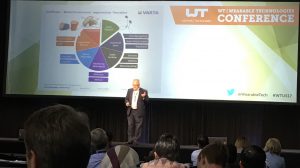
July 18-22, 2017:
FOSS4G Europe 2017
Marne La Vallée, France
The conference FOSS4G ( Free and Open Source Software for GeoSpatial) was held at ENSG (Ecole Nationale dès SciencesGéographiques) and it gathered together the users of FOSS4G and the developers to discuss the latest in the premier Open Source Geospatial gathering. A group of international geospatial experts in different sessions discussed geospatial data abstraction library, spatial dynamics of global economy, challenges in OSM community, creating semantic graphs in geospatial databases and FOSS web mapping applications. Geospatial analysis applies statistical analysis to data that has geographical aspect. It uses software of map processing spatial data. Its analysis goes further than 3D mapping and spatial statistics; its location algorithm is very complex and includes simulations of a very large number of configurations.
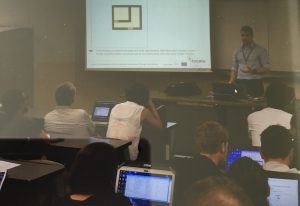
Since 1998 geospatial data abstraction library has been adopted by numerous software projects. The speaker discussed the current state of its users and explained that new driver can read GML files with complicated schemas. He explained various optimizations and the utility scripts for merging vector sources. The speaker pointed out that google cloud storage buckets and cloud optimized GeoTIFF rasters would provide better support for cloud hosted files. The next speaker discussed the ways an open analytical framework allowing us “to leverage and apply the power and opportunities present in open data”; the speaker emphasized on the importance of sourcing free open data from open data portals of the UN, FAO and world Bank.

Zverev discussed the challenges in mobile applications using OpenStreetMap. The speaker said: “open source community is not easy to work with.” And added: “Edits from map me users were occasionally reverted.” Berets talked about how to creat semantic graphs in geospatial databases. The speaker pointed out that number of geospatial datasets has sharply increased especially with the funding projects including Linked Geodata, GeoKnow and LEO4. “These datasets have been used in operational applications.” And the speaker added that geospatial information in knowledge graph such as Google Knowledge Graph has been present. The linked geospatial data sources help researchers to find out the current problems of representing linked geospatial data.

Gianinetto discussed a FOSS web mapping application for raising awareness about migration flows to Europe. Funded by the European Commission, the researchers aiming at educating the citizens by using a gamification approach. MIGRATE is developed with free and open source software. Questions and answers are sent in JSON format to the clients and geospatial layers are in GeoJSON using OpenLayers3. The speaker pointed out that data showing the ways that users’ perceptions change while playing the game and they increase the users awareness. The source code of MIGRATE is available under EU Public License. CTR Press
July 12-14, 2017:
MDM & Data Governance
San Francisco
MDM & Data Governance conference was organized by SourceMedia, the publisher of Information Management. The attendees included MDM professionals in a variety of organizations and companies; they gathered together to exchange idea and discuss the latest challenges in MDM. Currently master data is considered greatly important because it has a vital role in innovations and efficient outcomes. The speakers in different sessions discussed fundamental customer data integration (CDI), product information management (PIM), Big Data Governance tools, Cloud and Social MDM, Graph based MDM, future of MDM & data governance, maximizing MDM value, data governance solutions and a variety of case studies.
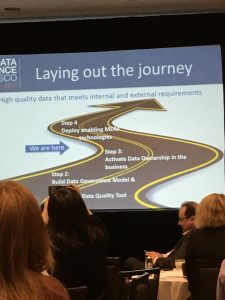
Aaron Zornes discussed what is driving business interest in the solutions MDM , CDI, PIM, RDM and data governance. He mentioned that he was the founder of a software company in 1982 and MDM Institute was founded in 2004. He pointed out: “Data governance is vital to success of MDM projects both initially and ongoing.” He explained how the MDM vendors have not delivered the data governance that is required and discussed mega vendors and mergers and acquisitions problems that need to be solved. He emphasized on both Physical and Virtual databases and the necessity of bringing data together and cleanse it. Reference data management, Operational MDM as a huge requirement for the performance, Analytical MDM in business intelligence and Collaborative MDM were discussed. Ed Allburn discussed data quality, CDI & MDM vendors. He explained case studies in different industries and how full MDM projects and early findings and trends of data quality applied. He pointed out that ETL process mistakes and fixing them is “hellishly expensive.” Discussing the Fortune 100Retail Pharma case study he mentioned that the problem was record matching fully optimized for all data, but not all data has the equal priority. He said: “More complex data = more risk of errors” He emphasized that Optimizing for general population can hurt VIP segment. He gave examples of People’s data: “Maria and Mario: are they two different persons or a typo error has happened.”
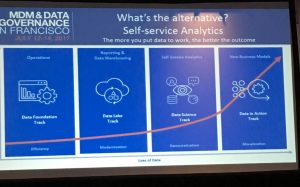
The speakers in the session reference data and MDM success discussed the reference data management and delivering value to the organization. They emphasized that Policies do affect the master data and information. Williams said: “My reference data is not your reference data.” And then he explained different reference data types: Public and external data, Semi private and finally Private and internal data. Director of product marketing in Orchestra networks said: “Unstructured information is also valuable” and he added: “Understanding the reference data is as important as the master data.” He discussed Reference data and unlimited alternate hierarchies and connected reference data sets across domain and time. He talked about the North America discussion: “a group believes it includes just the US and Canada; while another group believes Mexico is included too.” He said: “Reference data is foundational and connected to multiple domains and system and finally provides context and classification.”
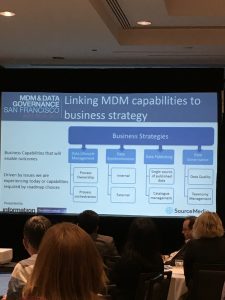
IBM senior offering manager discussed Graph based MDM and how graph technology used in MDM. He pointed out that Graph based MDM had changed all the vocabulary of the system. He discussed Graph databases facilitates visualization and exploration of networks and hierarchies. He said: “Graph allows us to find more obvious patterns.”
While the depth of data grows a graph database is very helpful. Hazlewood discussed how developers using IBM graph database technology to address the current challenges during development process.Data visualization tools and data storytelling are used as the foundation for efficient decision making. One of the biggest challenges in data management is making data understandable. Data visualization by visualizing business data analyses is considered an appropriate solution. Neo4j is the leading graph database and it makes data more clear and understandable. In the graph database, the logical model is the physical model. Many organizations are increasingly using graph databases in order to focus on the data relationships in the master data. The modern master data architecture does not depend on one technology and it requires a variety of database technologies. Companies are not looking for the mere data collection, but they are seeking to use data for real time business decisions. Graph database allows master data solutions and helps the process of unlocking the value in data relationships. CTR Press
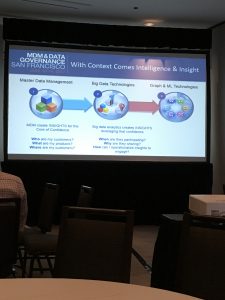
July 6-9, 2017:
OCD Conference 2017
San Francisco
The 24th Annual OCD Conference organized by International OCD Foundation. Since 1993, the Annual OCD Conference has been the only event that focused on obsessive compulsive disorder (OCD) and related disorders at the national level. The event brought together the mental health professionals and people with OCD. They discussed the latest treatments, research and practice in OCD. There were a variety of presentations and workshops. The organizer’s mission is helping those affected by obsessive compulsive disorder to be able to live productive lives. OCD is a “brain and behavioral disorder that can include obsessions and/or compulsions and has a negative impact on the life.”

Stacey Conroy discussed treating OCD and substance use disorder. She mentioned that about a quarter of people with OCD had a substance use disorder (SUD) too. She asked the audience to join the OCD SUD Special Interest Group. She said: “There is politics and economic sides of addiction that we have no control over; we only have control on medical side.” She pointed out the involvement of Pharmaceutical companies in selling opioids to the doctors. While talking about teenagers and the opioids addiction she emphasized: “we are partially responsible for the outcome.” One member of audience sadly described how she lost her teenage son who had anxiety and addiction two years ago and begged the therapists do something about it. The speaker explained that they could not go around politics or drug cartels and they could offer options on behavioral side. The panel discussing the ways of living the full life asked the audience to raise their hands if they had experienced pains some time in their lives and the majority of hands were up. The speaker mentioned: ” You are not alone.”

Dr Joshua Nadeau talked about enhancing motivation and engagement in exposure based treatments. He explained how the therapists facing barriers to motivation or engagement in exposure and response prevention (ERP). The speaker discussed the most common barriers to treatment engagement and the ongoing process of building motivation for treatment. Discussing tie to values: the things one finds valuable, he said: “Let them prioritize and choose: the same idea and different mechanisms.” He pointed out that good psychologists answer questions with questions. He said: “It doesn’t matter how far we go in the therapy but what direction we take is important.” He emphasized the importance of empowering the patients and added: “Behaviorists don’t believe in self esteem.” Dr Storch said: “New York is a very psychoanalytic society. Psychologists are good on arguing but bad on perceiving.” He also discussed the contamination disturbances and some therapy cases.

Jon Hershfield talked about the use of technology in OCD treatment. He discussed the online therapy and level of privacy while practicing. He mentioned that some therapists sending the confidential information of the patients to insurance companies. He explained Risk and benefits of online therapy. He mentioned the Benefits: no delay because of traffic and some clients can have access to a specific therapist; some may be less distracted and targeting the exposures at home in real time and finally home visit without the extra charge. The risks and issues of online therapy: disconnection due to the technical difficulties and being unaware and still talking; the client may bar the camera by holding up a Kleenex to the camera; not being aware if the patient has been drinking; email distractions and ear fatigue and screen time burnout. He mentioned a case when the client was scrolling on Facebook during therapy and denying it while the therapist could see the reflection on the eyeglasses of the patient. He said: “Therapist cannot see that ERP is being done.” CTR Press
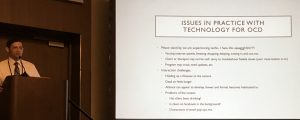
July 2-5, 2017:
Congress of the European Society of Biomechanics 2017
Seville, Spain
The 23rd European Society of Biomechanics congress took place at the University of Seville. This event was organized by the ESB (European Society of Biomechanics). The society was founded in 1976 with the goal of strengthening research and knowledge about Biomechanics. Currently it has over 1000 members. Also the International Society of Biomechanics (ISB) was founded at Penn State University in 1973 with the aim of promoting the study of all areas of biomechanics at the international level. The ISB supports international contacts amongst scientists in the field of biomechanics. Its upcoming event will be on July 22-27 in Australia. Biomechanics is the study of the structures and functions of the biological systems by using the methods of mechanics. The biological systems are far more complex than the systems built by human. Researches are done in a process of hypothesis and verification and numerical methods are applied in the bio mechanical studies. Biomechanics has an important role in the study of all biological systems. The participants of the conference were from a variety of disciplines such as anatomy, physiology, orthopedics, sport science and biomedical and mechanical engineering.
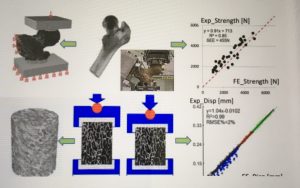
The scientific committee members for the ESB 2017 including scientists such as Javier Alonso from Spain, Angelo Cappello from Italy, Marcel Filoche from France. Marta Mora and Javier Andres research was about grasping posture predictions based on PCA. They discussed the use of principal component analysis (PCA) that is proposed to reduce the dimensionality of control problems in combination with neutral networks. The experiments were made with 16 right handed subjects performing the transport tasks of four cylinders. Enrich Dall’Ara research was about the validation of finite element models for prediction of bone properties at different dimensional levels. The speaker discussed that for improving clinical diagnosis of the bone related diseases we need to know how bone deforms at different dimensional scales from the whole organ to the cell levels. The speaker pointed out that for the validation process the recent techniques such as digital image correlation and digital volume correlations have been used. He discussed the challenges in the predictive abilities of FE models at micro levels and the ways of improving the spatial resolution of the strain measurements. He also explained how the model reacts in Vito preclinical and clinical applications.
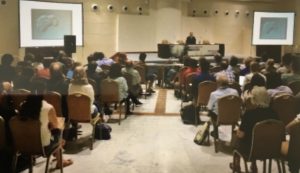
Damien Lacroix research was about tissue engineering that combines biology, biochemistry and mechanical engineering with the aim of regenerating new issues and organs. He discussed how they had been using a commercial 3D printed scaffold made of polycaprolactone by 3D biotech. The speaker explained the way they applied macroscopic loading onto those scaffolds and how the load transfer to the cell vary significantly due to large geometrical variation from one sample to the other. Shahin Ebrahimi and Francois Girinon from institut de bio mécanique Charpak in Paris, France research was about biplanar X-rays and personalized 3D reconstructions of human body in bio mechanical engineering. They have collected pairs of biplanar X-rays of 73 women and 50 men of various ages. And 172 radio opaque markers were uniformly placed on the skins of 12 volunteers. They evaluated the process by computing the deviations for distance between the radio opaque markers and the generated 3D surfaces at different regions. CTR Press

June 2017:
June 28-29, 2017:
The TV of Tomorrow Show 2017
San Francisco
At the TV of Tomorrow Show the executives, creatives and technologists working in the interactive and multi platform TV industry and about 200 expert speakers discussed the ways of utilizing TV trends today and how in the coming months these trends would evolve. Their focus was not on just watching TV on the TV set, but on video, AR and social media branding. Uygur, the Young Turks co founder mentioned that their news Show has 200 million views on YouTube each month and it has had 3 billion lifetime views. He pointed out: “people are afraid of taking risks and breaking the rules.” He discussed the multi platforms and videos on Facebook and YouTube. He emphasized on working on tags. He said: “News production and news reporting is a very expensive business.” He discussed how to make profit from news reporting and mentioned that they had received over two million dollars donations for hiring more reporters. He added: “The viewers are not just consumers but they are producers of contents too.”
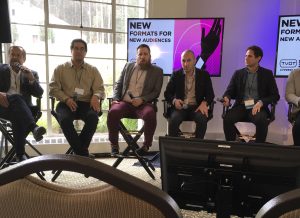
The panel discussing VR Creator were representatives of companies developing new VR technologies and those who pioneering storytelling in the new medium. They discussed the medium’s future and monetization potential of new technologies. Hurst talked about VR-only film festivals and added that lots of them had been the former hackers, now making VR films. He discussed digitalization and independent film making. Burrell pointed out that the story must come first and the design be made accordingly. Tankersley, CEO, Reality Fabrication said: “Consumers see VR in mobile; there are one million people in the United States who are obsessed with VR and they pay to get the experience. He added : “VR requires room and space; you can’t use it in a furnished room; you need special space for it.” He predicted that five years from now we would see the first hit.
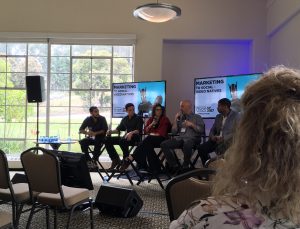
The speakers in the session: understanding social video programming discussed the new programming formats on social video platforms such as YouTube, Instagram, Snapchat and Facebook live. They talked about the effective monetization. Bob Nebrig said: “we don’t monetize at all.” He mentioned that some big corporations didn’t understand the social dynamics changes and emerging social behavior when audiences were involved. He added: “It is surprising to see what works and what doesn’t.” Lehrman mentioned: “Some books have more than 40 million readers; we can use that for video and TV.” He added: “So many choices are out there: you have to be people’s favorite.” He also discussed machine learning and training machine to recognize valuable contents. Holzer talked about creating contents on the platforms and mentioned: “there are 1% creators and 90% consumers.” Dan Altman talked about creating content and engaging the audience and how quick they get the feedback. He added: “people are notorious in self reporting.” The panel discussing Facebook VS YouTube mentioned that YouTube is the first search engine for people under 18 and the second search engine for people over 18. The speaker said: ” Facebook is behind YouTube and YouTube is far more advanced.” He talked about “cross posting”, using multiple Facebook pages for marketing and getting a more effective and cheaper distribution. Greenberg pointed out that brand must provide value to the customers and added: “Many people don’t watch crappy ads.”
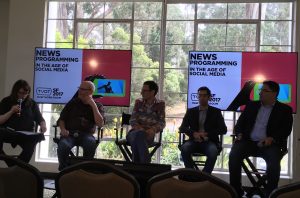
The speakers in the session: news programming in the age of social media discussed how news reporting affected by social media natives. Reid from CNN pointed out that at CNN they had very strict laws about social media and “fake news” on the social media. He mentioned that their global design team working on 34 different platforms. He pointed out that younger audience preferring to watch videos and the older ones preferred reading the articles. Farano, head of content, Plex said: “The majority of our audience are in 20s. And we are launching News next month.” The panel discussed how the traditional news providers trying to innovate and win back the social media natives. CTR Press
June 25-27, 2017:
Summer Fancy Food Show
New York
2017 Summer Fancy Food Show was organized by the Speciality Food Association. Since its founding in 1952, the Food Association has showcased speciality Food products at their annual shows. Their focus is on the innovation and creativity and their winter Show is in San Francisco each January and their summer Show is in New York every June. According to Phil Kafarakis, Speciality Food is a $127 billion industry. The speakers discussed the future of Food and Speciality Food industry.
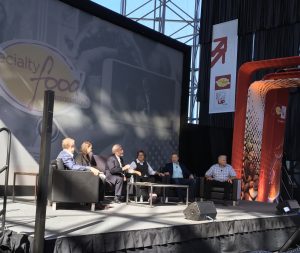
The panel discussing selling Speciality talked about Amazon and Wholefoods and the fast growing food industry. Phil Lempert discussed the Innovation bringing value and mentioned that Amazon is going to cut price in Whole Foods and Amazon prime shoppers are going to Whole foods. He anticipated that they would nail the food delivery. He said that more than 2,600 exhibitors displaying 180,000 products. He suggested changing the name from Fancy to Exciting Food show. He pointed out that shopping online lacks the special experience of shopping in the stores that we can see the products or sometime taste it or talk to the people about the products directly. Tony Stallone said: “We created E commerce. Things are changing in rapid pace and it enforces our strategy.” He emphasized on the necessity of knowing the customers.”Strange from WholeFoods mentioned that she cannot share what’s going on Amazon & WholeFoods and just said: “it is very exciting.” She pointed out that consumers going for transparency want to know the ingredients. She said: “We were the first to have bars and eating place in supermarkets.” She emphasized on creating enjoying experience for shoppers in WholeFoods. She also wished that fancy foods were available for more people.


The exhibitors from different countries around the world were presenting their products. Italy had the highest number of foreign exhibitors then it was France and Spain. SG diet from Bergamo, Italy exhibiting different products such as Biscotti di Riso Tondi; this cookie with more than 70% rice and eggs made from organic materials and has 30% less fats than other similar products on the market.

Les Jardins de Gaia from France exhibiting natural teas and vintages. Its representative Baumgartner said: “They represent more than 450 references in organic and fair trade teas and herbal teas.” Villa Cruz company from Spain produces and commercializes fresh stone fruits: peaches, nectarines and plums. It exhibited fig paste, diced figs and diced fig paste and a variety of fig delights. Chewys company from California presented pastries filled with walnuts, dates, raspberries and strawberries.
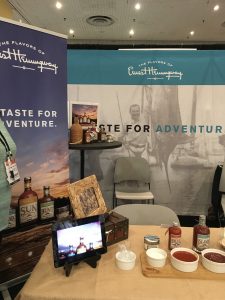
The American company, the flavors of Ernest Hemingway exhibiting tasty specialities and was decorating its booth with a variety of interesting Hemingway’s photos. Hammons American black walnuts exhibiting products completely free of pesticides or chemicals. Grandy oats from Maine has handcrafted organic granola since 1979 and presenting its latest products. Di Alfredo Foods exhibiting exceptionally tasty balsamic vinegar: Aceto Balsamico di Modena. Agro Rosa from Brazil exhibiting black and pink pepper broken berries. Noble Tree company from New York, a three-year old startup presenting Noblefree aromatic coffee. Lone peak labeling company exhibiting the labeler and its contrast to scale label and showing how cost effective is for labeling Food products. Klara’s, a taste of family tradition, exhibiting cookies made with the recipes from previous generations in Eastern Europe. Valsoia presenting Almond Milk Sandwich Vanila Gelato as plant based ice cream. According to its representative, plant based ice cream contributed $61 mm in growth over the past 52 weeks. Agrexpo from Greece exhibiting olives, vinegar and extra virgin olive oils.

Laurie & Pujalt from Lima, Perú presenting Peruvian, Italian and French style pink salt with fine herbs grown in orchards. A woman owned company, La NewYorkina, produces traditional Mexican ice creams with vanilla bean, chocolate and hibiscus imported from Mexico. Many exhibitors from Turkey presenting delicious Baklava. SoSalt company from Sicily exhibiting the salt from Sicily, Mediterranean sea that has a unique taste. Michel et Augustin from Paris, France exhibiting their latest cookie and jam products. CTR Press
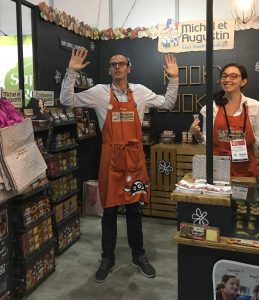
June 19-20, 2017:
DCD Webscale Conference
San Francisco
Datacenter dynamics converged conference was a full stack infrastructure ecosystem strategy and operations event. The organizers call it “Mud to Cloud”. The attendees were senior executives, technical teams and those responsible for building and operating high velocity business. The goal was discussing how cloud based data center is replacing the traditional enterprise data centers. The digital infrastructure, generate design and deep learning in webscale, cloud infrastructure optimization, risk management, managing data center and data center solutions were discussed. In how AI/ machine learning is being deployed to drive data center and cloud infrastructure optimization session, Rob Ober talked about all the data that is recorded and how unbelievable amount of data in cloud creates concern for the privacy. He discussed data center industry and distributed applications. He said: “AI especially inference will be everywhere.” “Inference can’t happen without training.”

Dr Julie Albright discussed the way that “internet-of-me” and smart cities mound webscale digital factories in order to deliver intense social and economic interactions. She mentioned that the “internet-of-them” will be the post human phase. She explained how the next generation growing up untethered. She pointed out that the next generation from very early stages, even before starting to speak, are using iPad and smart devices and any medium creates a completely new environment. Dr Albright mentioned that people used to gather around the TV and when everyone was watching the same things it harmonized the values and everyone got the same messages; but now it is returning to the individualism. She discussed the “tragedy of the commons when it is unregulated” and the end of trust particularly amongst the young. She explained how conformity, certain situations and group pressure can cause people do the wrong things. She said: “In digital environments dark army pushing people opinions like what Cambridge analytics do.” She showed the videos of Asch Conformity Experiment and a a 1-year-old who believes all media are now touch-screen-enabled. She seems not to understand that a magazine doesn’t take to pinching or prodding. The video showed how the one year old trying to pinch pages of the magazine like using an iPad. She said: ” Steve jobs has coded a part of her OS.”
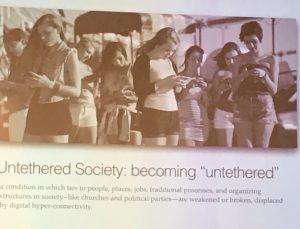
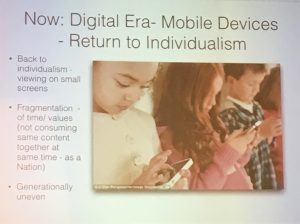
Madsen discussed risk management and upgrading the UPS system into an existing data center infrastructure. He emphasized the importance of planning and scheduling in every process and mentioned that since the financial crisis in 2008, a big changes from traditional one happening and now it is cloud based data centers. He discussed the two types: enterprise type of data center VS cloud type of data center. He pointed out that the costs keep coming down. Herb Villa talked about big data and IoT: challenging the edge. He explained the Industrial internet of things: IIoT. He pointed out that there is a new area: smart anything: transportation, building, everything. He described the Edge: Consumer edge & industry edge. He pointed out: “Not self driving vehicles but automated vehicles.” He discussed Edge VS Fog VS Cloud. He said: “With GPS in iPhone we are all moving data center.” He emphasized that Edge must rely on the cloud. He talked about the case when an executive’s computer was hacked while he was eating in a Chinese restaurant that caused him to loose his job and health. He talked about plugging in an infected USB drive and how it could install malware on the system and how the autoplay malware isn’t the only way USB devices can be weaponized. He discussed the technique for modifying a USB device’s controller chip so it can infect other device and take control of the computer and spy on the user.” ” According to the recent research nearly 50% of people will pick up a random USB stick and run through all the steps required to have their computer compromised.” ” Moving a computer within close proximity of the device it’s communicating with, the bandwidth improves and Fog computing is simply moving some of the computing power closer to the devices so that “the cloud” doesn’t have to be consulted for every little details. CTR Press

June 13-14, 2017:
Intrigue Summit
San Francisco
Intrigue Summit was organized by an English marketing training facilitation company called Salesgasm. This company provides training using free sales and marketing app for organizations and individuals. The features include free sales and marketing training, webinars, articles, and videos. The variety of sessions discussing visual discovery to inspire consumers, content marketing, mobile marketing, video marketing, tips for advertising and marketing using social media. Hulse discussed content marketing. She mentioned that she had a philosophy degree and explained how she used philosophy in content marketing and how to get the best results with the least effort. She raised this question: “can we get results without creating content?” She talked about creating data visualization and info graphics. She recommended Reddit as a very good source for finding good and funny contents. She emphasized on reaching Subconscious mind if we want to be really creative. “Data security content aiming at teenage audience doesn’t exist.” She explained the ways she used philosophy and psychology to get people say yes when she wanted. On the matter of psychological choices, she pointed out: “people choose the middle one when facing three choices so always put the important one in the middle.” She discussed generating data survey and creating story on survey.
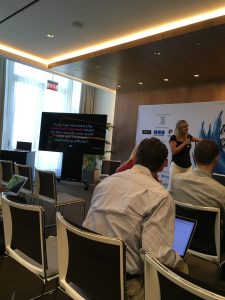
Rayess from Outgrow talked about growth hacking in our noisy world. He mentioned that in traditional marketing we just talked about our products, but now there is a Shift from selling to helping customers. He explained the case of using augmented reality in IKEA website that the buyer can see how furniture looks at their home. He emphasized on adding lots of value. “Customer needs to be engaged with not sold to.” The next panel discussed Mobile marketing and how to make the customer not only consume the content but create content too. They discussed turning quality users to super users by growth loop. About Push notifications the speaker pointed out that the effects depending on each person and some people delete the app after receiving too annoying push notifications. Video marketing session was moderated by Marcello Grande. He said: “A video is worth a thousand images or two million words. Video is the closest thing to the real and why it is so effective.” The panel pointed out: “By 2019 video content will be the driving factor behind 85% of search traffic in US.” Abramson mentioned that traditional marketing was in the decline and increasingly consumers soaking in digital content. He said: “Video is stickier. We achieved Huge increase in our revenue as the result of a single video on YouTube that had no expense for Symantec.” Yak Gertmenian from AOL talked about capturing audiences. He explained MoJo: mobile journalists and mentioned how to tell story economically and make everyone to consume.

Cavel talked about human to human marketing and explained how the word of mouth could be extremely powerful. Head of marketing in Uber said: “Google is the king of web and Facebook is the king of mobile.” He pointed out that B2B and B2C marketing tools were very different. He mentioned: “Facebook knows everything about you: name, location, phone, friends, contacts,…everything.” He emphasized on choosing the advertising strategy first and then advertising. Santilli from HashiCorp pointed out: “One principle is Trust; building trust always pay off.” He emphasized on choosing and pursuing quality. “Content as an opportunity. Content is not means of selling but means of engaging people.” He discussed their latest open source projects. On digital marketing, Moskovitz from Oracle talked about moving oracle to the next stage of social marketing. He pointed out: “People want to be informed; they don’t want to be sold. Try to think differently; but it is difficult because we are stuck in our habits.” CTR Press
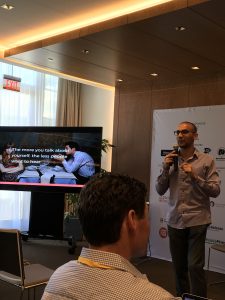
June 8-9, 2017:
Elm conference 2017
Paris, France
The Elm Europe Conference was organized by Elm team in San Francisco led by Czaplicki. Unlike JavaScript, Elm code is not producing runtime exceptions in practice. In fact, Elm uses type inference for detecting the problems in the process of compilation. According to Czaplicki, “NoRedInk has 80k+ lines of Elm, and after more than a year in production, it still has not produced a single runtime exception.” The attendees who were mainly Elm enthusiasts discussed different aspects of Elm: its virtual DOM implementation, visualizing data with Elm, Building Reorderable UI in Elm, Building Prezi-like Presentations with Elm, and Music Chords Charts in Elm. Elm is a domain-specific programming language for creating graphical user interfaces; it is purely functional and its emphasis is on usability performance, and being robust. Elm uses ports to communicate with Java script. It is allowing values to flow in and out of programs in order to provide communication between Elm and JavaScript.
![]()
The speaker pointed out that Elm has its own virtual DOM implementation which is designed for simplicity and speed. “All values are immutable in Elm, and the benchmarks can help generating fast JavaScript code.” Hampl discussed how to visualize data with Elm. He explained the ways of using Elm features to create interactive visualization apps. He pointed out that all data is immutable in Elm, as the result view is not able to alter the model. It is producing a new model upon each request that flows into view to be displayed. It is “memorized for the next roundtrip by the Elm runtime.” “The model lives across interactions.” Ziegan talked about how to build Reorderable UI in Elm. He discussed different questions with reordering such as:
“Does the user need a styled preview of the drop zone? Can the reorderable axis change between x and y while dragging? And finally can be achieved with a clean API?” Kuzmin talked about graphic programming and how to use WebGL in plain JavaScript. He explained how Elm can make graphics programming easy and robust in the same way as it made building UI’s easy. He mentioned that the WebGL library got a new home in the Elm Community organization. Version 2.0 came with lots of new features and improvements to the API. Sokol talkeabout his first commit to Elm-plot and how he was fighting the old habits of his component-based mindset, which over time resulted in several complete rewrites of the library. He explained the ways the issues were resolved and the compromises made. Schomay discussed Inversion of Control at the Framework Level. He mentioned that the framework works like a “run-time,” but it is embedded in a “component” inside.
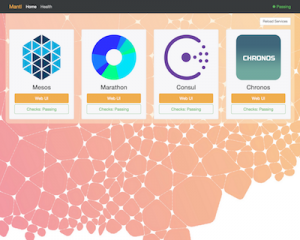
Rella introduced Dive, a programming framework written in Elm for building visual and animated presentations like Prezi’s. The speaker discussed the internals of the framework and compared two rendering approaches: Canvas vs. SVG. and showed creating Dive with Elm is not difficult. The next speaker discussed Music Chords Charts in Elm. The speaker explained that written in Elm, allowing to browse charts, add/edit them, fix errors and make links between charts. Peter Szerzo explained a multiplayer Elm game where players ate competing to find the first letter of a word written in a full circle. He explained the way Lettero is being refactored to split out its wordgame-specific parts from its core framework. CTR Press

June 3-4, 2017:
Bay Area Book Festival 2017
Berkeley
The third annual Bay Area Book Festival brought together a variety of American and international writers and book enthusiasts. More than 200 authors and speakers from around the world attended the Book Festival and took part in the intellectual explorations and debates. The panel discussing Hidden stories and telling the truth and a journalist from SF chronicle emphasized the importance of telling the truth about life in both non fiction and fiction. They mentioned that readers of literary fiction have more empathy. Tinti talked about her personal life, the challenges and the problems she faced throughout her life. She pointed out: “emphasis should be on NOW, not THEN.” She said: “I wrote about what matters to me and people responded.”
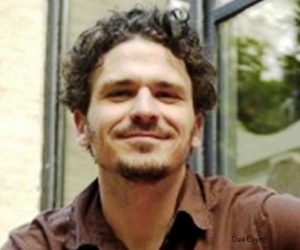
The panel discussing stories about Money, talked about both absurd and hilarious stories about money. Tech writer, Shafrir said:” My book is satire without intending to be this way.” She mentioned that she had attended Screen writing class in LA and as a journalist she used to write stories but not making up stories. She talked about the pessimistic view on tech by Dave Eggers, writer of The Circle: Mae, a woman in her 20s, starts her first day of work at a company which is called the Circle. She loves the beautiful campus and the tennis courts. The first line in the book is: “ ‘My God,’ Mae thought. ‘It’s heaven.’ and later we see the Circle in Dave Eggers’s novel: “The Circle,” will be a hell.” The company demands transparency and two of its many slogans are SECRETS ARE LIES and PRIVACY IS THEFT. Anonymity is banished. And she finally becomes one of them, as transparent as a person can be within the Circle: like the rest of them she is wired for the broadcasting of her every move. Even in the bathroom, the camera stays on, focused on the back of the stall door. Murray, from Ireland talked about his latest book and his life. He mentioned how before financial crisis, all big pharmaceutical and tech companies started to have branches in Ireland. He added: “then it came the Financial crash: the biggest destruction of wealth.” He emphasized that history teaches us nothing because people don’t learn from their experiences and always tending to believe: “This time will be different”. He used to work in a bookshop and his father is a professor of literature. He said: ” in the colonized countries, writers writing about masters and servants have different feelings.” He pointed out that the writers usually receive only seven percents of their books sales. Luscher from Germany talked about the broader European perspective and said his book was about an imaginary financial crisis in the future. He mentioned: “The next financial crisis will come soon.” He also talked about the huge support for translation in Germany and Switzerland and how governments in Switzerland and Germany finance the Literature Houses and literary discussion. He pointed out that in Germany and Norway the writers receive funds for promoting their books and reading their books in public.

Walter Mosley the writer of 55 critically acclaimed books and one of America’s best-known writers talked about his books that are various genres, from young adult to science fiction to politics. He talked about creating narratives that are entertaining and instructive. He mentioned that both his mother and father had a very strong personality. He talked about his life and the lives of the characters in his books. He said: “there has not been any black male heroes in the literature.” He added: “I don’t like to take side, but write about them.” “What I believe I write in nonfictional books.” He pointed out that White people had been treated like black people. He discussed Sub conscious and analysis of book experience. He emphasized that the most important thing is: “if you are not in fiction you don’t exist.” He talked about Power of words and added: “the only thing for writing fiction is understanding the poetry and Understanding how to deal with pressure.” He said: “I do believe in the soul.” In the response to the question: ” who are your favorite writers?” He said: ” I have favorite novels, not favorite author.” He mentioned The Whale and One Hundred Years of Solitude as his favorite books.
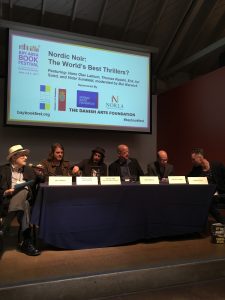
In the Nordic Noir session, Lahlum, writer from Norway mentioned that he is active in politics and is a serious chess player. He mentioned that people in the Nordic countries read a lot. He talked about his own unconventional life and mentioned: “People hide unusualness but I don’t. Unconventional people take the world Forward.” And then added: “It is my opinion I have to respect it.” Sundstol from Norway mentioned: “now is the peak time for the Nordic crime books.” He emphasized that Nordic countries having the best school systems in the world. The Nordic authors including Rydahl from Denmark said: ” in Nordic countries, murder is low, but there are lots of disappearances; some people leave their families and no one hear from them anymore.” He talked about his latest book and its translation in English. Two writers from Sweden who have written many books together talked about their journey from being a musician to being writers of crime and psychological novels.
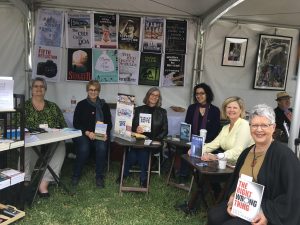
On poetry session, Layla Long Soldier talked about her poetry book: “Whereas”and being a Native American poet in America. Her poem: ” when in doubt I’m told, write what I know. So I peel my eye to the moment, my love of it. I wake from a dream about running I interpret as the desire to get there.” Charif Shanahan talked about his mixed identity: his mother from Morocco and his father, an American Irish. He said: “beauty is truth and getting free.” He also talked about his poetry book: “Into Each Room we enter without knowing”. His poem: “the words: horse, donkey, mule; the words: there is no identity; the words: one plus one equals three. Knowing not to call a hill a mountain.” Michael Shewmaker from Texas talked about his poem and identity and mentioned he lives in San Francisco but he feels Texas as his home and he mentioned: ” it is not right to see America just as a white country.” Three poets in the panel: Soldier emphasized visual in poem; Shanahan emphasized truth in poem and Shewmaker emphasized clarity in poem.
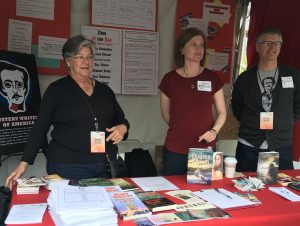
Dacher Keltner, professor of psychology talked about the Power Paradox. He is the director of Berkeley Social Interaction Lab. He has developed a theory of power exploring an integrative account of the effects of power on human behavior, the acquisition of power and its disinhibiting effect and social consequences of exercising it. He mentioned: “Power and status imbue almost every facet of life. I have found that ideological partisans with power display their dispute in more stereotypical fashion, that elevates social status leading to disinhibited social behavior, and that power, can be from experimental manipulation.” He explained how they positioning undergraduate students in Berkeley in different experiments and analyzing the results. He mentioned that power affects everything: how to eat, how to look and how to talk. He pointed out that power is seen in every type of relationship. CTR Press
May 2017:
May 23-24, 2017:
The Incite Marketing Summit 2017
San Francisco
The Marketing Summit was organized by the Incite Group that is a business intelligence company for large corporations. The senior corporate speakers discussed the latest trends in marketing, personalization, content & story telling and marketing attribution. The panel discussing scalability and strategic alignment talked about content marketing strategies for ensuring consistent operations. Javier Boix from StoryLab &Corporate Communications discussed Brand communications and mentioned that focusing on changing people’s mindsets was what pharmaceutical companies relying on. He compared traditional communication approach with the modern approach. He emphasized on the elements of human story for brand awareness. He explained external validation and research and how the Pharmaceutical industry is under fire. He said: “Social sharing and comments give us direction and digital analytics for consumers comments is a must.”
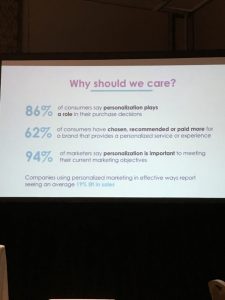
Gary Davis talked about the cost of privacy in a hyper connected world. He discussed the dramatic increase in high profile breaches. He discussed what happens when privacy goes wrong for customers and business. He emphasized that data is highly valuable and is the new oil. He mentioned that digital criminals nowadays looking for data : organizations data, hospital records and financial information. “Global cost is $158 per record for data breach and it differs from industry to industry and finally it takes over a year to recover.” He mentioned that loss of brand value could be over $300 million. He mentioned that last year talktalk company was breached by a 14 year-old teenager and the cost was $64 million and considerable reductions of share price. He pointed out: ” there is a distinction between Security and Privacy. He gave the latest statistics: 51% have not clicked on online ads, 44% withheld information, 36% have stopped to use website, 32% not downloaded an app because of privacy concerns over Security tools of devices, 29% have stopped using apps, 28% stopped online transactions and finally 74% limited their online activities due to privacy concerns. He explained how increasingly people are becoming privacy sensitive: “when marketers asking information that they don’t need, the consumers give false information.” He talked about Internet of things and how they gather people’s private information. “Tech impacting the future of privacy.” He pointed out that France passed a law last year that children can sue their parents for the breach of privacy for posting their pictures on Facebook without their consent. Digital Republic Bill, passed in October 2016 in France and resulted in a considerable changes for companies and organizations in terms of Privacy. Data subjects have now the right to know how their data is stored and can decide how it be used and the personal data be deleted without delay if it was collected when data subjects were minors. Also French Data Protection Agency have increased the fine from €150,000 up to €3 Million euros.

David Siegel from Investopedia discussed the way Investopedia use the latest data for smarter insights. He talked about their data driven approach to marketing attribution and content distribution. He discussed growing audience for growing business and how video growth and Referral for driving more traffic can facilitate business development. He mentioned that their website attract more than 200,000 daily unique visitors globally. The panel discussing signaling the noise talked about the importance of finding meaningful metrics in big data. Chad Weiner from Mozilla pointed out that discipline made Mozilla performance more efficient and added: “our brand is based on Trust.” He said: “We marketers relying too much on data. All the technologies are not useful for all the organization at all the time.” “We needed a tool for processing the data and investing in the culture of data understanding.” He emphasized on the necessity of moving quickly and adapting in marketing. Vaccarello talked about understanding I in ROI. ROI (Return on Investment) is a very important calculation for making sure the long-term viability of the business. She said: ” It is not enough to build in a profit margin on the product or service being offered.” She talked about her experience in salesforce when she was told by head of finance: “you spend too much money as the head of online marketing and she replied I make lots of money for the company too.” She talked about different businesses and how to invest and the revenue targets in marketing. She then explained how marketing is measured. She added: ” there are 170 versions of marketing budgets and how to allocate money.” She mentioned that sales team and finance team usually define the relationships and revenue and control over investments. Echosect , a Canadian company provides users the ability to find, filter and visualize publicly available content from the social media around the world. CTR Press
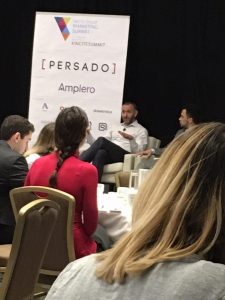
May 22-23, 2017:
Chief Innovation Officer Summit
San Francisco
Chief innovation officer summit was organized by innovation enterprise. Professionals and executives from a variety of enterprises and industries gathered to discuss innovation challenges and solutions. The panels and speakers talked about discovering solutions for the problems by adopting innovative measures, how to adapt to a variety of market disruptions, how to use the most innovative technologies, ways of building relationships with the highest potential entrepreneurs, the future of corporate innovation, leveraging the power of big data and machine learning in different industries, and how to manage innovation programs efficiently.
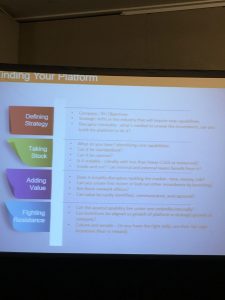
Zimmer, a trends data scientist from Google talked about leveraging the power of big data to uncover trends in different industries. He discussed Google fashion, beauty and food trends reports. He talked about the ways of utilizing Google’s search bar queries to discover insights and how to find unexpected glimpses into user intent. He explained how to use the power of Google data to create value for the clients. He pointed out that innovative approach should be used in order to find signals from the noise in the big data. He discussed creating micro trends based on what people are searching on Google and how Google benefits from it. He explained Deep dive, how Emojis was trending in 2015, how data can influence innovation. He pointed out that data challenges opinions; data connects the dots; data inspires innovation. He emphasized on the importance of identifying the behaviors behind the trends. He added: “Bring data and help innovators take better decisions.” Briganti talked about her company that made the first Innovation talent profiling algorithms and how this algorithm is highly predictive in identifying the talents. She said: ” Innovation talent is priceless.” Our journalist took the online test that was an intelligent multiple choice test, smartly designed to find talents, but it can prove the point that human still can beat the machine and algorithm. The test is effective if the employees or potential employees answer each question honestly; if they don’t, algorithm cannot do much about it. Tonti pointed out: “Innovate or die: 75% of Fortune 500 companies will be replaced by start ups using AI and machine learning by 2027.” The next speaker talked about G2G: Googlers to Googlers program that is an internal educational program and participates must have the minimum two years work experience in Google. She pointed out that when mandatory became optional, the participants increased considerably. She mentioned many of them after finishing the term left Google for the startups.
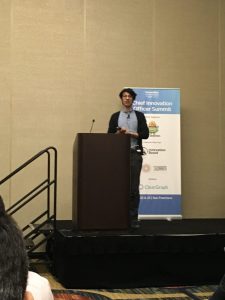
Vigneault mentioned that he had dropped out from Stanford to start his company: ClearGraph. He said: “Conventional access is not enough; we want an intelligent search.” Drylie from Humana mentioned: “90% of people don’t like hospitals they prefer to be cared at their homes.” He discussed expanding care platforms into mobile and wearables. Legeme from LinkedIn talked about his own personal journey from Nairobi to Silicon Valley. He pointed out that the differences were huge. He discussed learning and innovation and how slow innovation and lack of performance costs millions of dollars. He talked about data driven sales coaching in LinkedIn. He emphasized: ” Innovation needs right ideas, right strategies, right process and right team that leads to innovation.” He mentioned that the presence of people with self awareness and different perspectives in a company can be a must and he added: “This is the true diversity not just diversity of colors.” He talked about Innovation & Working against the tides and from roadblock to opportunities.
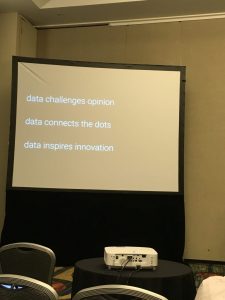
In the exhibition halls the representatives from a variety of companies discussing the strategies and innovation solutions by their companies. Corporater’s business management platform puts the users in control and enables analysis of performance and execution of the strategy. AchieveIt’s platform provides both meaningful insight and ability to drive results. One2Team provides “real time visibility of the gap between the results achieved on the field and target.” Moovila enables execution across departments “by creating tasks, monitors the strategy’s progress with the real time view of status.”
CTR Press
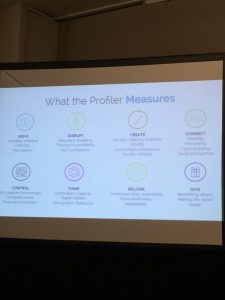
May 14-18, 2017:
Predictive Analytics World 2017
San Francisco
Predictive Analytics World Conference was a “cross-vendor event” for professionals working on predictive Analytics. The goal was achieving broader picture of new opportunities and the latest innovations in data science and machine learning and also leveraging big data for prediction and ultimately driving higher value. The speakers discussed predictive analytics in financial services, government, high technology and publishing. Golany discussed how to achieve success in predictive analytics. He mentioned that we should consider many factors such as precision and complexity of the problem and the required timelines for the solution. He pointed out that change wasn’t easy and explained the process of creating the general model for managing the change, especially when the opposition to the change appeared. He added: “Adoption of analytics is the result of creating and managing changes.” He emphasized that leveraging a dynamic analytical approach can achieve great values. The next speaker talked about using machine learning techniques for predictive modeling. He pointed out that traditional approaches can be time consuming, but automated machine learning can make fast and efficient predictive models. He said: “predictive analytics is central to the big data.” Predictive analytics is information technology that produces a predictive score for each customer and predictive models assign the scores. Predictive analytics optimizing website behavior to increase customer engagement and decrease customer churn. It predicts who, when and why customers stop buying or renewing subscription. It provide the solutions for the intervention and how to intervene for achieving the most efficient result. The speaker pointed out that “successful businesses don’t just rely on their products or services to grow;” they know that they need to leverage the data in order to have more accurate understanding of customers’ behaviors. Predictive analytics informs the businesses the actions need to be taken with each customer based on the customer’s score.
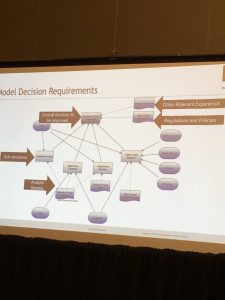
The next speaker discussing machine learning and predictive analytics mentioned that artificial intelligence makes machine learning scalable and inclusive. He added: “A good platform gives you control by analyzing lots of data.” He emphasized on the process of cleaning data and pointed out that automated machine learning cleaning data faster. The speaker discussing churn modeling said: “There are two types of churn: active and passiveone.” He pointed out that defining the target variable of churn is not easy: sometimes customers don’t renew the subscription and sometimes they refuse to pay fees for some services and they don’t typically mention the reasons. He emphasized on the planning of targeting low engaging customers and deciding how much to spend on each customer. The next speaker discussed fraud screening of card transactions and mentioned that FICO scores 65% of all the world’s payment card transactions for fraud. He mentioned that they use advanced analytics to monitor new trends in the global payment card. They use big data and mathematical algorithms to predict consumer behavior and this has transformed all of the industries. They leverage open-source standards and cloud computing in order to maximize flexibility and reduce the costs. Galusha talked about retention modeling in uncertain economic times. He discussed strategic client retention. He explained using seasonal models and trending models for assigning retention efforts. He mentioned that the new methodology didn’t need retooling and stabilizing performance.

Elder discussed the heart of analytics problem and stock market predictions. He explained how to build a model and stimulations. He discussed when predicting is more accurate for achieving good results and when the cost of trade off is problematic. He explained how to use lift charts, random and perfect models and designing metrics. He emphasized the need for thinking very creatively. Ramirez talked about predictive analytics success in Fintech and banking. He pointed out that Fintech helping the creation of new products and new customer experience. He mentioned that the focus should be driven by organizational priority and adoption of predictive analytics in the organization. Malin discussed making better products with predictive analytics. He emphasized on using data to improve product performance. He explained different anomalies in drones: general anomaly, contextual and innovative anomaly. He pointed out that consumers and their devices are directly communicating with businesses and companies should find out what features customers like or use in the future. Platt talked about data and predictive analytics in city government. He discussed how to use data for operational efficiency and mentioned that they used customer service model and consider the city residents as their customers. He explained how they createdMGoogle forms for the real time data and added that it was customized and people could choose from which part of the city to receive the notifications about the incidents.
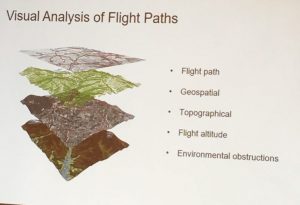
The keynote speaker discussing the centrality of understanding the audience mentioned: “Six out of ten people in the USA get their news from the social media.” The panel discussing women in predictive analytics talked about the opportunities and challenges. Ciot from Montreal talked about women in tech and her internal passion for math and statistics. She emphasized on creating the environment and culture that support women to share their opinions and creating more open dialogue. Gloukhova from Stanford emphasized on pursuing the values and criticized the Unconscious biases and supported inclusion. In the exhibition hall, data Iku representative talked about the case study, voyage privé that is number one exclusive members only travel club and offering up to 70% off 5 star hotels. The company started its operations in France and currently has over 25 million members worldwide and offices in France, Italy and Spain. They use machine learning approach tooffer each customer a customized selection. Jackson Lewis representative explained their services and capabilities. They modeled innovation and creativity to embrace the digital age. They use big data applications to help their clients overcome workplace challenges through technology, human capital and analytics. CTR Press
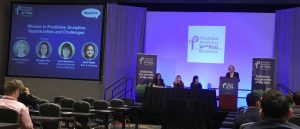
May 7-9, 2017:
Festival of Media Global
Rome, Italy
Festival of Media Global was a conference about the largest spending brands, media owners, tech companies and agencies working on the international level. One of the main topics discussed was the process of decision making in “the $1 trillion international advertising industry.” The attendees in the conference were CMOs, executives, media professionals and innovators from around the world. The panels and the speakers were from the most important players in the industry. Poler talked about success, fear and taking risks. She discussed her own journey of achieving success through taking risks and overcoming fears. She emphasized on using the fear for tackling business decisions and creating the effective solutions to the challenges each industry facing. She talked about her one life, born in Venezuela and moving to the United States 10 years ago, determining to overcome all her fears and to break free from the routine lifestyle and beginning to pursue a creative lifestyle fearlessly. The next speaker discussed the role of a CMO in the competitive market. He pointed out that currently many CEOs considering to do this role too in order to be more effective and to achieve the desired result. Their comprehensive approach help them to see the big picture and make better decisions. The next panel discussed how revealing and analyzing the mistakes can leads to the success in the global advertising industry. They emphasized the necessity of being brave and facing the mistakes and learning from them.

Gal discussed artificial intelligence and the future of ads. The speaker explained how AI has had an important impact on the advertising industry. “Companies using machine learning in order to decide which impressions to buy, which consumers to target and what version of an advertisement to show to each individual.” Gal emphasized that algorithms can deliver useful and targeted messages to the customers in the real time based on the data received. The speaker explained the ways advertising agencies can perform effectively in the age of AI. The next speaker pointed out that at the heart of any innovation we see the human experience and involvement. He emphasized the human element in the process of digital transformation and added that the human experience changing the way the companies engage with their customers. Quaroni talked about the leading programmatic marketing platform that using artificial intelligence at the big data scale for optimizing ROI for the global agencies. Bridge discussed the development of deep audience insights and creating a unique strategy and putting the customers’ needs at the center of each activity. He discussed the challenges in the modern publishing industry and explained the need of setting out steps in order to maintain the leading position in the media industry. The next speaker emphasized on understanding of the disruptors in each industry and gaining insights for promoting scalable innovation for customers. He emphasized using a platform that can be used for promoting the integrity of digital marketplace. He emphasized on being relevant and using the personal experience and new knowledge for creating value. The next speaker mentioned that number one news agency in Italy is the only agency that has its own offices both nationally and internationally and its goal is independently covering and distributing the global news. CTR Press
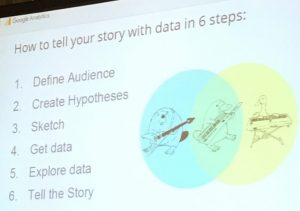
May 4-5, 2017:
Customer Experience Conference
New York City
The Annual Customer Experience Conference brought together more than 4,000 executives across a variety of industries to discuss the ways of simplifying the customer’s experience more effectively. The goal was finding the better ways to develop the customers experience and gain their supports and ultimately increasing the revenue. The panels and speakers discussed how to define the customers for each industry: to know their needs and what they are looking for and their feedbacks. They emphasized that achieving the greatest success in customer experience needs knowledge and data and how to analyze the data. The speakers expressed their insights on bridging the gaps between companies and the customers.

The panel discussed how to develop companies’ CX economic value. The speaker mentioned: “not everything has ROI” and added: “we need to put customers into the center of everything that our company does.” He pointed out that sharing information and collaboration among the companies in each industry in the customer experience should be discussed and emphasized. The speaker emphasized on “moving from decentralized to centralized CX functions. Usually CX, customer experience, refers to understanding their emotional and psychological interactions with the companies involved. When this understanding is positive, it leads to customer loyalty and directly affects the economic value and revenue of the company. The speaker discussed training the customers service staff and the employees in the call centers who directly interacting with customers and delivering the ultimate customer experiences should be considered as the main priorities. He explained that analyzing the customers’ feedbacks is both art and science. When the right behavioral questions in the customer’s surveys are asked, the process of analyzing would be more meaningful. He emphasized on viewing the big picture and having a comprehensive view of each customer.
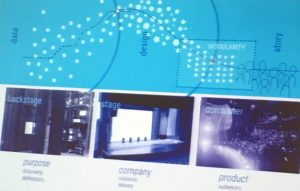
The panel discussing differentiating the company from the competitors in the industry explained the ways of increasing customer engagement, analyzing the customer’s purchase behaviors and setting customers satisfaction as the goal. The speaker discussed leveraging customer experience, using social media to increase interactions with customers, the ways of driving innovation and creativity and looking for the right content effectively. She emphasized on knowing customers and their behaviors across generations and cultures is critical for each company in order to achieve the success in the highly competitive market. CTR Press
http://ctrcompany.com/ctr-press/


